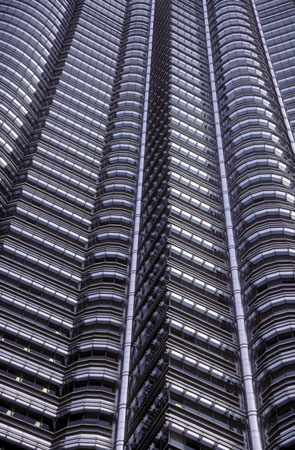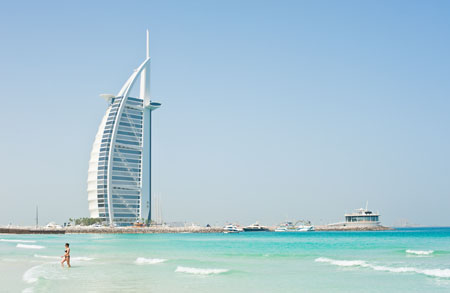It may be argued that the approach to photographing vertiginous modern architecture is somewhat different from that typically used for more traditional structures. Converging verticals need no longer necessarily be a major concern because modern glass and steel structure often make dynamic images when the camera is directed way above the horizontal and even rotated to make the building lean across the frame. The new architectural styles are also generally more tolerant of variations in lighting and can often be photographed in harsh light as well as the softer light early and late in the day. They often reveal stunning reflections that are in themselves a source of great images, and when seen against interesting or even pure blue skies they can make eye-popping subjects.
 There are of course several quite different photographic approaches to a modern building. The building's exterior may be bold and futuristic but also quite difficult, even impossible, to capture in a single image - at least for a ground-level photographer. Many new buildings are squeezed in to existing sites of fixed dimensions and surrounded by other structures of various ages and styles. It is sometimes simply impossible to get a good composition incorporating the whole building. In circumstances such as these try gaining access to high viewpoints in the surrounding area. Public buildings, multi-storey car parks and church towers may offer views but if not try getting permission to access to the roof of a private office block. Distant views of this type will always incorporate at least parts of adjacent buildings, but this can be used to provide context or contrast between new and traditional architecture.
There are of course several quite different photographic approaches to a modern building. The building's exterior may be bold and futuristic but also quite difficult, even impossible, to capture in a single image - at least for a ground-level photographer. Many new buildings are squeezed in to existing sites of fixed dimensions and surrounded by other structures of various ages and styles. It is sometimes simply impossible to get a good composition incorporating the whole building. In circumstances such as these try gaining access to high viewpoints in the surrounding area. Public buildings, multi-storey car parks and church towers may offer views but if not try getting permission to access to the roof of a private office block. Distant views of this type will always incorporate at least parts of adjacent buildings, but this can be used to provide context or contrast between new and traditional architecture.
Another rewarding approach is to concentrate on some aspect of a building's shape or detail. Careful composition and choice of camera angle can produce wonderful abstract images based upon geometric shapes, patterns, forms, reflections, curves and colours, all crafted by modern architects and engineers from steel and glass.
A final approach is of course to photograph some aspect of a building's interior, although this obviously involves arranging access and gaining permission to undertake the photographic work. This can be difficult as many structures are closed to the public and any photographic activity may be viewed with suspicion. However, this does not mean access is impossible to achieve. Bear in mind the business or activity going on within the building, and be as flexible as possible with regard to the time of a visit. Weekends may be ideal because may cease, but it is unlikely that too much choice will be offered. If access is allowed, a photographer may be escorted by a security guard and restricted to a certain period of time, so it is worth knowing what you intend to do from the start.
Advanced planning is always worthwhile, so try to visit the location before undertaking any photography. Be aware of the photographic possibilities before the shoot and make sure you are properly equipped with all the necessary lenses and accessories. Staircases, foyers, high galleries, glass or decorated roofs and ceilings, balconies and interesting detail of all types are worthy of attention. Light always presents a problem of some sort. Different light sources mix with daylight streaming through large windows, so colour temperature is likely to be difficult to handle. Contrast may also be high so expose for the midtones. However, much of this can be addressed in Photoshop at a later stage. Shoot everything in RAW mode to maximize opportunities for adjustment.
 In some cases, photographers are approached by security guards or police who become suspicious that you may be up to no good. The best approach is complete openness. Explain politely your purpose and keep on public land unless you have obtained permission to access a private location. The use of a tripod is sometimes declared as the reason for asking photographers to leave. Some security officials will claim that a tripod represents a safety hazard in a public place, but that is a matter of judgement and commmon sense. In other cases, particularly indoors, those responsible for buildings may cite concerns over tripod feet damaging the floor. Whatever the problem, remain polite and open.
In some cases, photographers are approached by security guards or police who become suspicious that you may be up to no good. The best approach is complete openness. Explain politely your purpose and keep on public land unless you have obtained permission to access a private location. The use of a tripod is sometimes declared as the reason for asking photographers to leave. Some security officials will claim that a tripod represents a safety hazard in a public place, but that is a matter of judgement and commmon sense. In other cases, particularly indoors, those responsible for buildings may cite concerns over tripod feet damaging the floor. Whatever the problem, remain polite and open.
Getting to know a building or structure is an important part of planning photographs. Where the opportunity presents itself, take time to walk around the area at various times of day to observe how its appearance changes and how the light and shadows fall upon it. After one or two visits it will be much easier to decide the best time of day to capture it at its best. If the structure is bold in design, as many modern buildings are, be bold in the approach to the photography. Be prepared to take risks with your images, see it differently and use your own vision rather than following ideas that have been well used.






